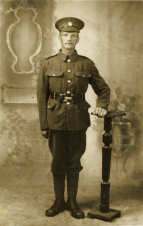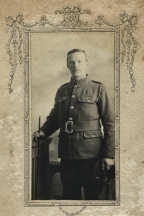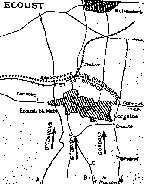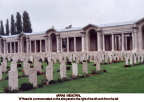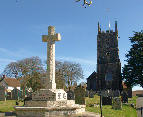
|
| HOME PAGE |
| MEMORIAL CROSS |
| HISTORY of the CROSS |
| ROLL of HONOUR |
| LINKS |
Private
Walter Heard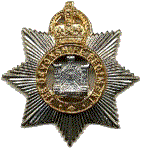 26073 260739th Battalion Devonshire Regiment, 7th Division, 20th Infantry Brigade Died 02.04.17 aged 35 Walter Heard was born in early 1882 in Dolton, the sixth child of Robert Heard, a blacksmith, and Betsy, his wife, who kept a grocer’s shop in Chapel Street, Dolton. As was normal for those days, the children grew up to help in the family businesses. Charlotte, worked with her mother in the shop. John and Alfred, became blacksmiths like their father. Walter became a groom/coachman, and Ernest described in the 1901 census simply as ‘worker’. Finally the last daughter was Emily, aged 13 and on the point of leaving school. Ten years later, the 1911 census reveals that Walter, aged 29, was a married man. A possible ‘great house’ where he might have worked was Stafford Barton. He had married Ellen Turner, aged 29, on the 8th August 1904 in the Dolton Parish Church. By 1911 Walter, now described as a labourer, and Ellen were living at ‘Addisford’, Aller Road Dolton with three children who had all been born in High Bickington. First was Kenneth Empire, so named because he was born on Empire Day 1905, followed by Ernest Robert in 1906 and Betsy Ellen in 1909. Much later, a last daughter, Mary C., was born in late 1913, and was between three and four years old when her father was killed. Just before the war, the family moved to Seckington Lodge on the outskirts of Winkleigh, probably because Walter had become the groom in Seckington House. We have two photographs, which can been seen by clicking HERE, showing Walter and his famly taken in the garden at Seckington Lodge, in about 1915 and 1917. We can be sure that if the photogragh taken about 1917 was prior to his death, Walter would have carried it with him in France: he might well have had a copy of it on him when he was killed. The photograph taken about 1915 was given to the site by Neville Heard, the third child of Ernest, and Walter Heard’s grandson. Sadly, Walter’s records did not survive the blitz, and unusually neither did his medal record, so we have no definite knowledge either of his enlistment date or the date when he first went to France. However, Neville can remember as a child being allowed to look at his Great-Grandfather’s medals, and he is quite sure there were three of them. This is significant because it shows that besides the British War Medal and the Victory Medal, Walter had also earned the 1915 Star Medal given only to those who had served in France or Flanders before the end of 1915. Here there is ‘proof’ that Walter was serving in France with the 9th Devons at some stage before 1916. We have three photos of Walter Heard on the web-site, and they show us Walter at two very different stages of his life. They are all undated The first, as a young man of about 18 shows him in about 1900 wearing the uniform of the Devon Militia, and it was given to the site by Marion Weekes, Ernest’s daughter. It was apparently taken at Woodbury during the Militia’s annual camp on Woodbury Down. The Militia were the ancestor of the Territorial force that was raised in the years before the First World War. In May 1881 the Childers Reforms, undertaken by Secretary of State for War Hugh Childers, had restructured the infantry regiments of the British army. A continuation of the earlier Cardwell reforms, Childers created a network of multi-battalion regiments. In England, Wales and Scotland, each regiment was to have two regular or “line” battalions and two or three militia battalions, numbered the 3rd, 4th and 5th Battalions. This was done by renaming the numbered regiments of foot and county militia regiments. In addition the various corps of county rifle volunteers were to be designated as volunteer battalions. Each of these regiments was linked by headquarters location and territorial name to its local “Regimental District”. The photo shows that Walter Heard certainly joined once he had reached the age of 18. There was a huge surge of enthusiasm among young men to enlist as a part-time volunteer soldier in 1899 and 1900, as a response to the outbreak of the South African War, a war that was indeed the catalyst that eventually led to the creation of the Territorial Army. War broke out between Britain and the two Boer Republics of the Transvaal and the Orange Free State in October 1899, but there was little expectation that the reserves of the Militia, Yeomanry and Volunteers would ever be called on to fight in a war which, as Britain saw it, was to bring to order a mob of unruly farmers. However ‘Black Week’ of December 1899 witnessed three major defeats, Stormberg, Magersfontein and Colenso, and by the end of the war in May 1902 no less than 448,000 men had been deployed, among them 45,000 militiamen, mainly Yeomanry. The Devon militia were not called on to go to South Africa. The term of enlistment was for a definite term of four years, terminable on three month’s notice (or penalty of a fine) with the possibility of re-engaging for a further four years. At the age of 23 Walter would have served in the Devon Militia for at least the four years of his contract, bringing him to the year of his marriage in 1904. We do not know if he signed for a second term. We have two undated photos of Walter as a much older man, in his ‘30’s wearing the uniform of the Devons. These are two variations of a portrait taken on the same day in a studio, very likely an enlistment photograph. He carries a ‘swagger-stick’, often issued in 1914 to volunteer recruits, a practice discontinued later for those joining Kitchener’s New Army. This indicates he enlisted quite early, certainly in 1914. The next clue is given in the Devonshire Regimental casualty records themselves: Heard, Walter, b. Dolton, Devon, enlisted Barnstaple (Winkleigh, Devon) 26073, Private, killed in action France and Flanders 2/4/17. 9th Battalion. Barnstaple was the headquarters of the two Territorial battalions of the 6th Devons, the 1st/6th being the original Territorial battalion of the Devons in 1914, the 2nd/6th being formed almost immediately as a flood of volunteers joined the battalion in the first weeks of the war. The entry indicates that Walter Heard might well have enlisted in one of these battalions, choosing to go back to his old (now renamed) battalion from his early days of territorial service. A list of those Winkleigh men joining at once was published in the Chumleigh Deanery magazine and Walter Heard’s name was not among them, so that he seems to have waited a short while before enlisting in Barnstaple. The fact that he had a uniform is significant. When the 9th New Army Battalion was formed the only ‘uniforms’ available were a stock of pre-war ‘blue’ uniforms, of the sort issued to soldiers convalescing in hospital. The reason that Walter might have eventually preferred the New Army to the Territorials can be suggested by the history of 6th Battalion in the opening months of the war. On the outbreak of war on 4th August, the 1/6th Battalion of the Devonshire Territorials, part of the Devon and Cornwall Infantry Brigade, was one of the four battalions already in camp for their annual two weeks training programme at Woodbury Common near Exmouth. The 1/6th was commanded by Lt. Col. N.R. Radcliffe with 21 other officers and about 700 other ranks, and like most Territorial battalions was well under strength. So great was the rush to join this Territorial battalion that it was immediately named 1st/6th, so that a second duplicate battalion, the 2nd/6th could be raised. Although in the opening weeks of the war the Territorial Army was still considered to be a Home Defence force, many men were coming forward in the hope of going overseas. Meanwhile, those already serving in the battalion immediately left Woodbury and proceeded not to Barnstaple but to Plymouth where they shared a congested night with the 1/5th Battalion in their Drill Hall, without any facilities for bedding, feeding, cooking or washing. On August 5th the 1/6th moved on to Fort Renny, near Plymouth, mounting guard at various points in case of an immediate German invasion - much feared at the time. On 9th August the 4th, 5th and 6th Battalions all entrained to move to Salisbury Plain. The 6th had an unfortunate journey, which started with a 10 mile march to Plymouth station. The train then took them to Salisbury station where, in order to provide some sort of breakfast, the CO had commandeered the entire supplies of the refreshment room. The march to camp was a further 17 miles, with each man carrying rifle, pack and 100 rounds of ammunition. Only half the men completed the journey, and the C.O. was reduced to commandeering, and having to pay for local motor transport to pick up all the stragglers. The 6th Battalion was attached as ‘Army Troops’ to the Wessex Division when very soon the Division as a whole received orders to proceed direct to India to set free for field service in France some of the regular battalions serving there before the war. The 6th Battalion received a special message from the King which included the encouragement that the Battalion was ‘helping him and the kingdom as much as if they had gone straight to the front’. Although the Territorials had repeatedly been told before the war that they were merely being asked to form a force for Home Defence it was quickly recognized by Lord Kitchener that they would be needed for much wider service, partially trained though they were. However, overseas service remained voluntary and in order to preserve the Territorial forces (rather than decimate them by transferring the volunteers to New Army battalions) the conditions of service were quickly altered - much to the hostility of many parents who were violently opposed to the idea of their sons serving overseas in a war area. The young men themselves, however, were mostly keen to join the great adventure, and in the Territorial Battalions of the Devons most men immediately volunteered. By August 31st those in the 6th Devons who had failed their stricter overseas medical examination, together with those who wished to remain as Home Service men, were returned to Barnstaple to serve as a nucleus for a second-line Territorial battalion that was being raised, the 2nd/6th. For those who had volunteered and who remained in camp, hopes of going to France were dashed on 16th September when the 6th received its orders to proceed to India. The order was accompanied by a special message from the King to console them for losing the honour of being among the first Territorial units sent to reinforce the B.E.F. The Battalion sailed on 9th October landing at Karachi on 11th November. Walter Heard could well have considered that as a married man with a wife and three children to support, he was better off serving the country at home or later in France, rather than leaving them to go to India on the far side of the world. If this was the case he would have returned to Exeter, where two New Army battalions were being raised - the 8th and then the 9th Battalions of the Devonshire Regiment, and Walter Heard would have been under great pressure to have volunteered to join the 9th Battalion, which was very short of recruits. The 9th Battalion was originally formed at Exeter on 15th September 1914 as part of ‘K2’, the second hundred thousand men who volunteered for Kitchener’s New Army. However, by the time that the more popular Devonshire Territorial and Yeomanry battalions had been filled, together with the 8th Battalion, (the first of the two New Army service battalion of the Devons), volunteer recruits for the 9th Battalion were few and far between. As a result, the original 9th Battalion contained a mere eighty Devonians, the remainder coming mostly from London and Birmingham. The battalion was originally attached as Divisional Troops to the 20th (Light) Division, but was transferred to the 20th Brigade, 7th Division, when it landed in France on 28th July 1915. Once in the army, Walter would have carried out his initial training in the 3rd (Reserve) Battalion in the Exeter depot before being drafted to join the 9th Battalion. Since we cannot be sure when he first went overseas, though we can be sure it was sometime between 28th July and 31st December 1915, it is useful to give a brief history of the 9th Battalion from their arrival in France until early 1917. Both the 8th and the 9th Battalions of the Devons were both completely shattered at the Battle of Loos, September 25th 1915, after which both were in various stages of recovery. The 9th had lost 15 officers and 461 men, and by 30th September their fighting strength had been reduced to 12 officers and 325 men. We do not know if Walter was with the 9th Battalion at Loos, but in any case the battalion was rebuilt with large drafts, so that by December 1915 numbered 30 officers and 1,002 other ranks, although most of the reinforcements had received only a few weeks of rudimentary training. Out of the line in December, the 9th Battalion was now converted for a short while into the 7th Division’s Pioneer battalion, operating under the Royal Engineers and engaged on mining, road-building and railway construction. However, by the end of February 1916 they were back in the trenches opposite Fricourt, then a quiet sector on what was later to become a major area in the Battle of the Somme. It was a period of unending toil, mining, patrolling, improving the trenches, wiring and trench raids, but it was also a period of very few casualties. Between October 1st 1915 and June 30th 1916 1 officer and 16 men were killed, 6 officers and 96 men wounded, and one man missing. On July 1st, the opening day of the Battle of the Somme, the 20th Brigade including the 9th Battalion led the attack on Mametz. Prior to the battle, counter-battery fire by the Germans had destroyed the Devons’ front line and support trenches and new ones had been dug 250 yards further back. The 9th crossed No Man’s Land and took the German front trench and a short stretch of trench beyond it but could do no more. The casualties were terrible. In the 9th Battalion only one of the 18 officers who had gone over the top survived, eight of them killed. Of the men 141 were killed, 55 were missing, 267 wounded - 463 out of the 775 who had gone into action. Those that had survived remained in the line for several days, consolidating the limited gain, assisting in taking Fricourt and burying their dead in a special Devons cemetery at Mansell Copse. The 7th Division, which had lost in all over 4000 men, then went into rest until July 13th. During these few days the battalion was once again ‘rebuilt’, with large drafts amounting to 486 men coming from almost every other West Country and Southern regiment. It is curious to relate that of those 486 only 46 actually came from the Devons 3rd. Battalion in Exeter, though in fact large drafts from there were being sent to other units, a strange method of encouraging the ‘esprit de corps’ so trumpeted by the authorities. On July 14th, the second stage of the Somme offensive was conducted as a night attack, but this time the 9th Battalion remained throughout in reserve in Caterpillar Wood. Even so, they took 90 casualties from shell-fire, of whom 15 were killed. There followed four days in reserve, after which the 7th Division attacked again. Again the 9th Battalion were in reserve, this time north of Bazentin le Grand Wood. Divisional rest was then ordered for the 8th and 9th at Ailly sur Somme, some of the Welsh and Midland drafts departing to join their own regiments, and the 3rd Devons sending out further drafts from Exeter. After 5 weeks rest and training the 9th Battalion now mustered over 800 ‘other ranks’. Within days however, in a further disaster, it was to be decimated yet again. On 3rd September the 7th Division moved into the line, the 9th Battalion ‘debussing’ at Mametz and proceeding to Montauban for an attack on Ginchy, west of Delville Wood. The village was taken after heavy casualties, but could not be retained. Eight officers and more than a hundred men were killed or wounded, for very little gain. After Ginchy the 8th and 9th Battalions were given 10 days rest, to be rebuilt once again with big drafts. The 9th received 90 men from the 3rd Battalion, all well trained, followed by 131 mainly Leicesters and South Staffords. On September 18th both Battalions moved into a very quiet sector for the next six weeks between Armentiers and the Douve, in trenches unchanged since October 1914. Less than 30 men were lost during this time while a further 17 officers and 40 men joined, including some returning previously wounded. In November the 7th Division marched south over several days to reach Doullens, and then Mailly-Maillet on 23rd. On the march several drafts had been picked up amounting to 220 men, bringing the battalion once again to strength with over 800 men. The Battle of the Somme was now over, and normal trench life returned to the thick mud in the trenches just East of Beaumont Hamel, trench foot becoming a special problem as winter come on. Casualties were very low, and it was a time of ‘live and let live’ for both sides. The last days of January and the whole of February saw the 8th and 9th Battalions in reserve, training and assimilating further large drafts, partly to offset the large sick-rate during the winter. The 9th now mustered 46 officers and 1,030 men, and were in rest at Mailly-Maillet, organising carrying parties up to the line. On 14th March 1917 the German withdrawal to the new Hindenburg line began all along the line from Roye to Arras, and the 9th Battalion now found itself just South-West of Ecoust, passing over ground devastated and obstructed in every way by the retreating Germans. It was now the task of the 7th Division to assault the Ecoust-Croiselles line, part of the outer defences of the Hindenburg Line itself. Meanwhile casualties were taken in the front line activities in front of Ecoust, losing in March one officer and 13 men killed with a further 43 wounded. (A detailed account of the activities of the 9th Battalion, taken from the battalion war-diary during February and March 1917 can be accessed by clicking on the Related Topic in the right hand colunm. It is an interesting and typical illustration of a battalion in ‘Divisional rest’ during this stage of the war.) The 7th Division now had the task of assaulting the first outposts of the Hindenburg Line, the two villages of Ecoust and Bullecourt (see Ecoust map on the right). While the 9th Battalion had been in rest, the Australians had secured a position in the Hindenburg Line east of Bullecourt, but in order to maintain this position Bullecourt had to be taken at all costs, and the task was given to the 7th Division. The village of Ecoust, just south-west of Bullecourt had to be taken first, however, and this attack was fixed for May 2nd, to be carried out by the 8th and 9th Battalions. The position was formidable with belts of wire defending the machine-gun posts lying in a hollow invisible to the attackers. There were, however, two gaps in the wire in the two roads leading from the south into the village, protected of course by machine-guns. Prior to 2nd April attempts had been made to capture these posts, but all had failed. The 8th Battalion attacked the village itself, the 9th the north-west outskirts on the road to Croisilles and then beyond it to the railway embankment behind the village. The weather had been atrocious - rain, sleet, snow and bitter winds - but April 2nd was bright and clear. The battalions had formed up during the night 200 yards from the gaps in the wire. At 5.15am when the dawn barrage crashed down, the men dashed forward, the machine-gun posts were taken and the 8th Battalion took the village after hand-to-hand fighting. The 9th Battalion did equally well, though held up by a machine-gun in the cemetery on the Croisilles road. After heavy casualties the battalion secured its objectives on the embankment and the road to Bullecourt, and dug in as best it could. The account of the battle of Ecoust as reported in the Battalion War-Diary, can be quoted in full: April 1st: Battalion moved to bivouacs in Gommecourt and at 11.30pm moved forward into the line in front of Ecoust.There was some confusion in the record of casualties in the battle of Ecoust. The composite list of casualties for the month of April, attached to the War-Diary gives slightly different figures. 2nd April 1917: 24 Other Ranks, 4 Officers killed in action. The attack had been a great success. On the flanks of the 20th Brigade, Croisilles had been captured and the Australians on the right had taken Noreuil and Lagnicourt. Ecoust remains a proud honour for the Devonshire Regiment, but losses had been severe. Among those who died was Private Walter Heard. Since his remains were never found he was listed as ‘missing’, and his name recorded on Bay 4 of the Arras Memorial which is in the Faubourg-d’Amiens Cemetery, in the Boulevard du General de Gaulle in the western part of the town of Arras. The cemetery is near the Citadel, approximately 2 kms due west of the railway station and commemorates almost 35,000 servicemen from the United Kingdom, South Africa and New Zealand who died in the Arras sector between the spring of 1916 and 7 August 1918, the eve of the Advance to Victory, and have no known grave. The most conspicuous events of this period were the Arras offensive of April-May 1917, and the German attack in the spring of 1918. The work of the 8th and 9th Devons at Ecoust and of the 7th Division as a whole had not been in vain. On April 9th, Easter Monday, British and Canadian forces launched simultaneous offensives at Arras and at Vimy Ridge. The Hindenburg Line was pierced and 5,600 Germans taken prisoner. The whole of the German front-line trench system was overrun in three quarters of an hour, the second line within two hours. By nightfall even part of the third line was in British control. In the end, however, the final break-through could not be achieved as blizzards of snow and the arrival of German reinforcements plugged the gap. Casualties on both sides were fearful. Walter’s descendents still live in the Dolton and Winkleigh areas. For a time his son Ernest was working for the council as a road-mender, and Ernest’s son Neville has given this site a photograph of his father working with his team. He stands in the middle of a cheerful group, hands on hips. Neville has also provided a photograph of Walter’s children with their mother Ellen. Kenneth’s daughter, Evelyn Allen, lives in Dolton, Ernest’s son Robert Walter Heard at Copplestone, his brother Neville in Winkleigh, and Ernest’s daughter Marion Weekes also in Winkleigh. Ethel Turner, living in Dolton, is the daughter of Alfred Heard, Walter’s brother. Sadly, very little is remembered about Walter, their grandfather, and it is reported that when his wife Ellen died in a nursing home, her husband’s medals were sold and all her photos and memorabilia were thrown away. We are very lucky to have the three photos of Walter Heard in uniform, first as a younger and then as an older man, together with a few older family photographs which can been seen by clicking HERE. They are an invaluable record. 14 October 2011 |
|---|
| [Top] | Back to MEMORIAL CROSS |
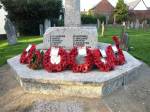
Click on an image for a larger picture |
RELATED TOPIC |
| 9th Batt. Devons Jan-April 1917 |
